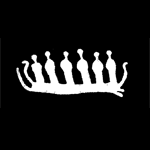|
|
Week 38
The last week of the season arrived and we have documented all the carvings located on the island of Orust. In addition, on the very last day of this work we found another two carvings at Rålanda which means there are five known carvings. This is one of several valleys with no known carvings existed prior to our documentation. Other areas where no prior finds have been made but now have proved to harbor concentrations of carvings are Hvena in Röra parish, Hoga in Stala and Bö in Långelanda. Another interesting observation is, that in some valleys with equally wonderfully smooth rocks, there are no carvings at all. We have discovered more than 100 carved surfaces on this island but only three of these carvings are figurative.
This week our new Report arrived from the printers; The Carvings at Lökeberg. It is a very select volume of prints done in spirit of Baltzer. This exclusive edition can be purchased at Vitlycke museum in Tanum. |
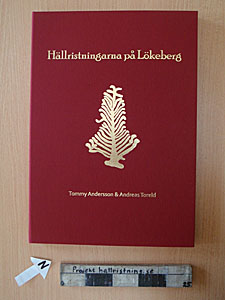 |
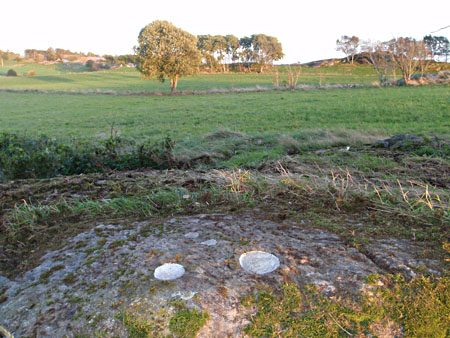 |
|
Our beautiful Report on the figure-carvings of Foss parish. |
Tegneby 272:1 at Hoga. The last of the previously known carvings that we documented on Orust. |
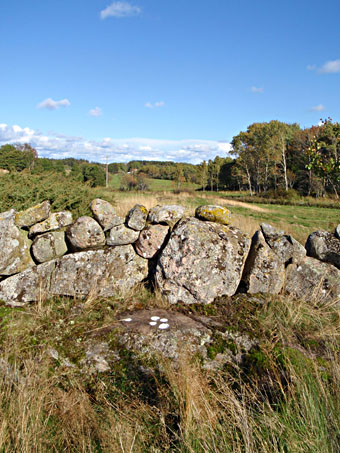 |
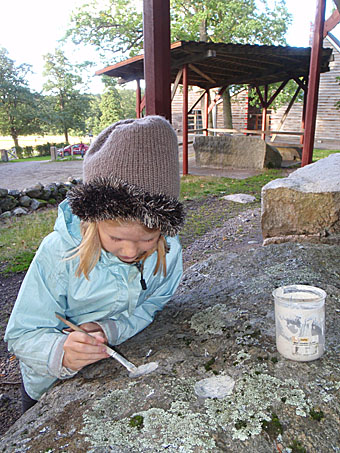 |
|
New find at Rålanda on the last day of fieldmork. |
Andreas daughter Elvira painting Morlanda 85:1. The carving has been moved to Vitlycke museum. |
|
Week 37
A week of Swedish fall weather with varying conditions; some days sunny and other days of just terrible weather! We have been continuing work in the central parts of the Tegneby flatlands and there are many previously known cup-marks placed on the rocky impediments in the fields just south of the Tegneby parsonage.
It proved to be a relatively easy task to find new ones. We have documented 31 surfaces and of these, 21 are new discoveries. Even though we saw several nice smooth rock-surfaces we could not discover any carvings with other figures than cup-marks.
Carving at Tegneby 85:1 on the farm Loppetorp placed next to a high vertical cliff overlooking the valley facing west. |
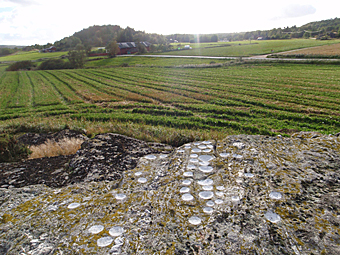
|
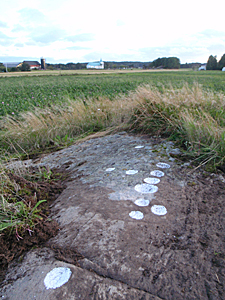 |
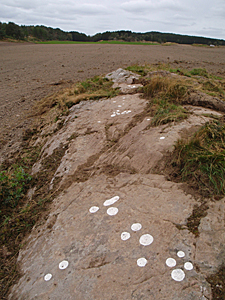 |
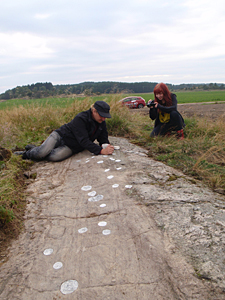 |
|
Tegneby 163:1 at Kallefors, deep and distinct cup-marks, almost intact. In the background looking south, the Tegneby church. |
A new find at Lunneslätt farm, south of the Tegneby parsonage with 45 cup-marks. |
Andreas daughter Julia, a college student, is filming our work for a school-report. Here, she is filming at Tegneby 141:1. |
|
Week 36
A week of lovely weather and many new finds. We started out at Rom in the southern end of Tegneby parish and we visited some known cup-mark sites and we found several new ones including one with 55 cup-marks in a tight cluster. These sites are all strewn in the landscape around southernmost farms at Rom.
In the middle of the week we visited Tossene parish where Ingemar Niklasson has made some fabulous new finds near the church. Earlier, there was a dense forest here but now it is open pasture land. The area is of national interest since it is a cultural milieu with a considerable concentration of rock carvings.
Several times, Aina Barnevik, the founder of our institute and who also has her family home here at Orust, vistited us. She was with us when we discovered and documented a carving-site at Rålanda that, in addition to 46 cup-marks, also had 7 long grooves. Previously, there were no documented carvings in Rålanda and this, of course, makes our discovery all the more important. |
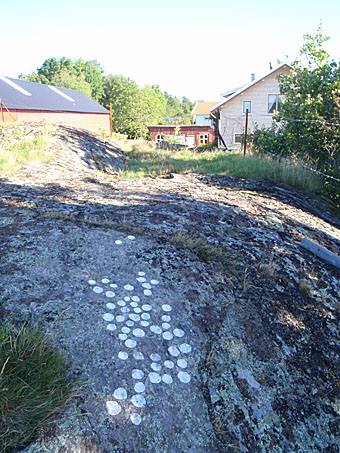 |
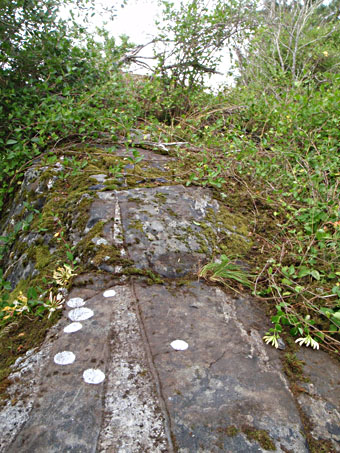 |
|
A new discovery; tight cluster of small cup-marks at Rom. |
New discovery at Rom, Tegneby parish. Cup-marks on the darker bedrock between the lighter streaked surface. |
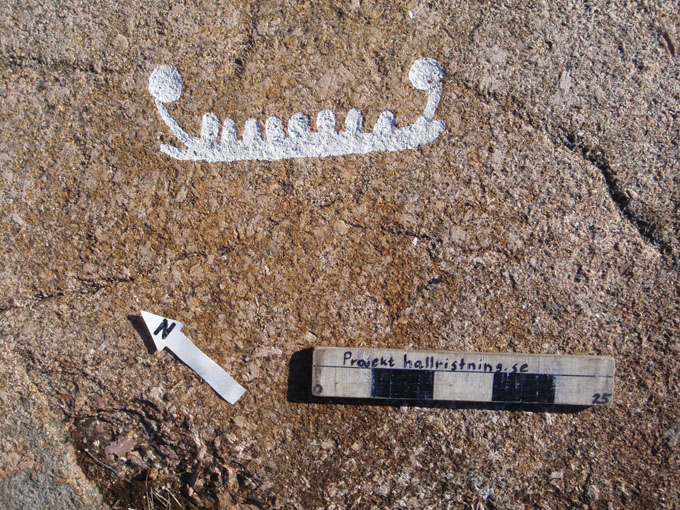 |
|
A new discovery of a ship at Tossene with stem and stern ending in a cup-mark. Tossene parish. |
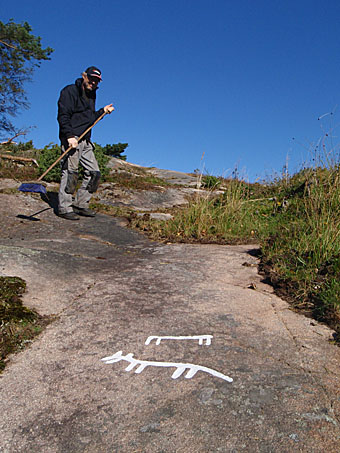 |
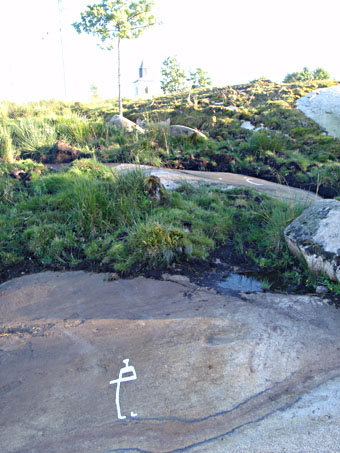 |
|
New find in Tossene of animal images. Above, a proud Ingemar Niklasson who found this carving. |
New find. Human figure at Tossene, not quite finished, leg missing. Another, barely visible new find of a ship in the background and Tossene church even further back at the horizon. |
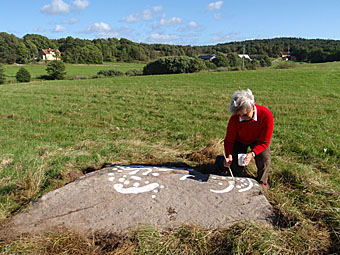 |
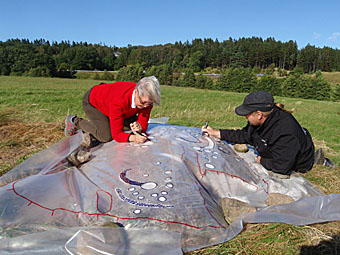 |
|
Aina is filling in a newly discovered carving in Rålanda, her native home in the background. |
Aina and Tommy documenting the new find at Rålanda. |
|
Week 35
Our first week of field-work this fall. We are back on the island of Orust where some parts of Stala and Röra parish left as well as all of Tegneby parish. Our first stop was to document the first known find of human images on the island; a discovery that we made last year and are now ready to document. This find has gotten a lot of press-coverage and local media such as the newspapers Bohusläningen and Orust Tjörn Tidning, and Radio Väst. We especially want to thank the property-owners Ann-Marie and Hans Abrahamsson for enjoyable chats around the coffee-table.
We made an inventory and documentation of the remaining parts of Stala and Röra parish. At Hvena, Röra parish, we found six new cup-mark sites. In this area there were no previously known carvings. Next week we shall begin in Tegneby parish at Rom. |
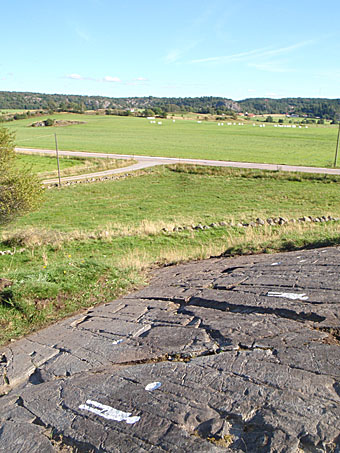 |
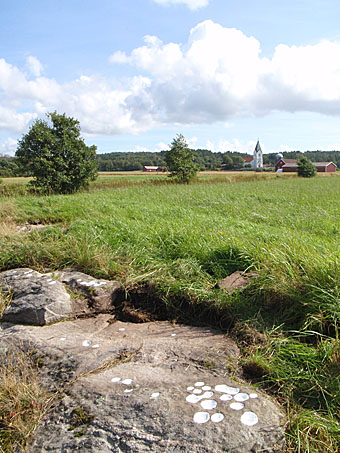 |
|
New finds of human images at Hoga, Stala parish. |
Cup-marks near Stala church. Stala 271:1-3. |
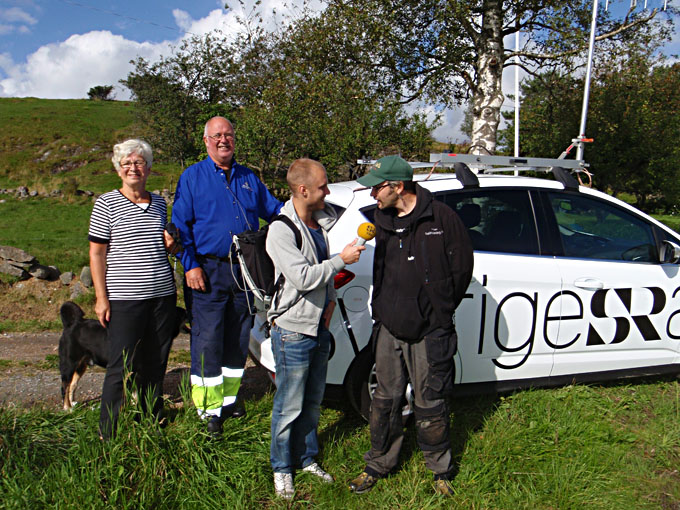 |
|
Radio Väst pays a visit and did a live report on the site of our new discovery of human figures at Hoga. Pictured are property owners Anne-Marie and Hans Abrahamsson being interviewed by reporter Anders Abrahamsson. |
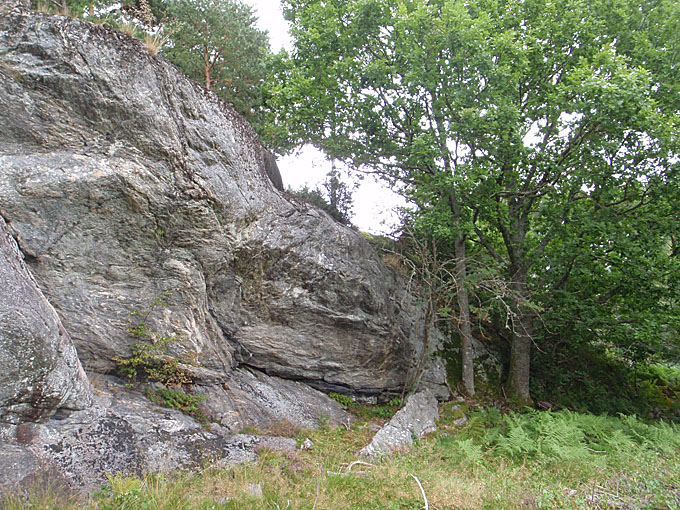 |
|
This rock, in front of the steep rock-face, is covered with cup-marks. Stala 66:1, at Långeby. |
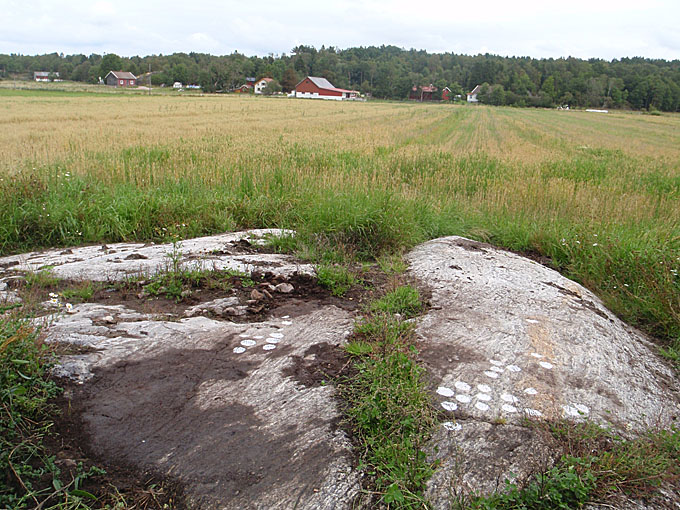 |
|
One of the new finds at Hvena, Röra parish. |
|
Week 24 and 25
These last couple of weeks we have been documenting several small carvings in Svarteborg. Most carvings in this parish have never been documented using modern methods. The best depictions are those made by Baltzer at the end of the 19th century but the ones from Svarteborg (or Tose parish, as it once was named) are not of good quality. At Svarteborg 16:1 only two carvings, one ship and one cup-mark, were previously known but we found yet another ship and the same goes for Svarteborg 9:2 where we found several additional ships and one human figure. Between the very beautiful sun-wheel at 10:2 and the human figures at 10:1, a small ship was discovered.
At the end of week no 24 we were visited by Saga who, in 2009, helped us to document the great carving at Brastad 14.1.
The great ships at Staxäng, Svarteborg 14:1 and 14:2 had earlier been covered over using plastic and mineral wool. When we arrived most of the covering had blown off. In the parts that were still covered the rock was abnormally damp and the mica and gneiss was quite soft and porous. Also, ants had colonized the crevasses and had damaged the rock even further. Our opinion is that, at least in this case, the cover meant to protect had done more harm than good.
On the last day of the season this year we made two new discoveries; one cluster of cup-marks in Bärby and one very superficially carved ship in Medbo. Also that day, we documented Svarteborg 1:1 at Medbo.
Next fall we plan to finish documenting Orust and next spring we plan on returning to Svarteborg. We will then document the large, and in large parts unknown carvings at 4:1 – 6:2 at Bärby. These carving measure between 50 and 100 square meters and we would be most grateful for any help with our work there. If you are interested in helping, please let us know. |
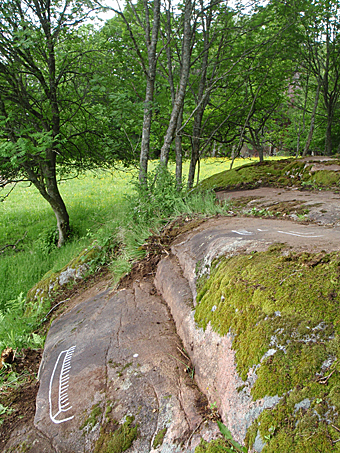 |
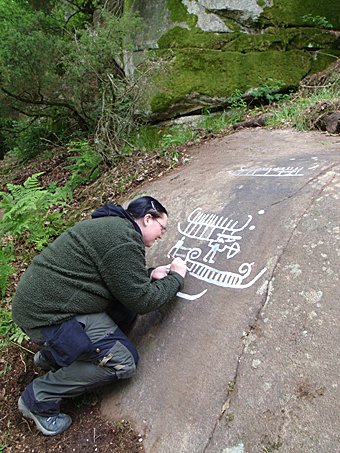 |
|
Ship. New discovery at Svarteborg 16:1, Bärby. |
Saga painting in the carving at Svarteborg 9:1. |
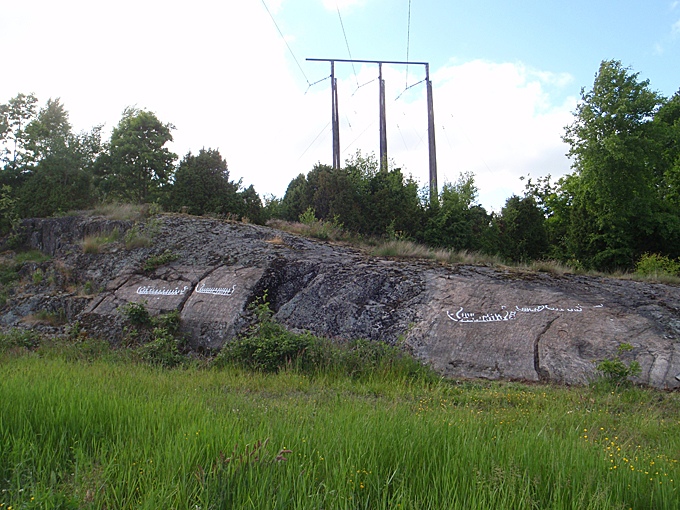 |
|
The large ships at Svarteborg 14:1 and 14:2 at Staxäng. |
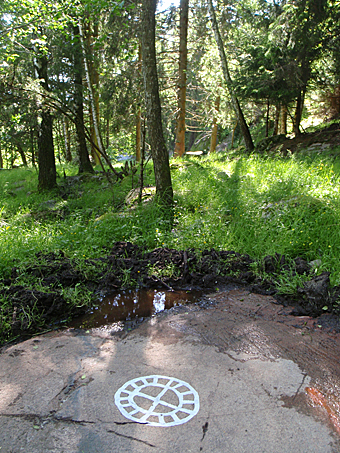 |
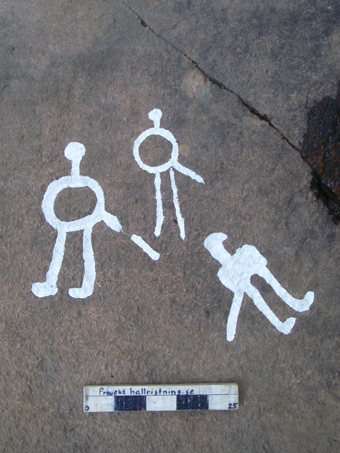 |
|
The wheel at Svarteborg 10:2 was documented by Baltzer. |
Human figures at Svarteborg 10:1. The two large ones were documented by Baltzer while the one in the middle is a new find. |
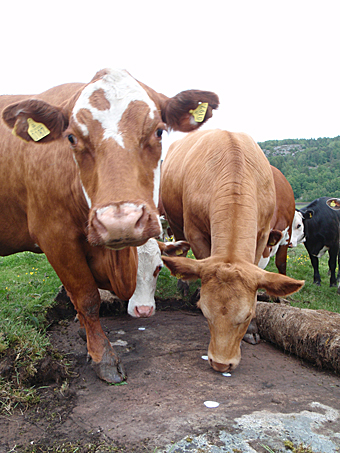 |
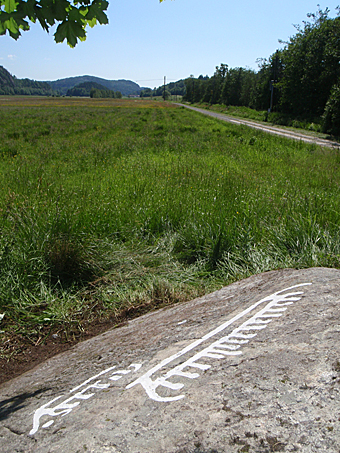 |
|
Sometimes others help us “sniff out” new discoveries. |
Svarteborg 1:1, at Medbo. |
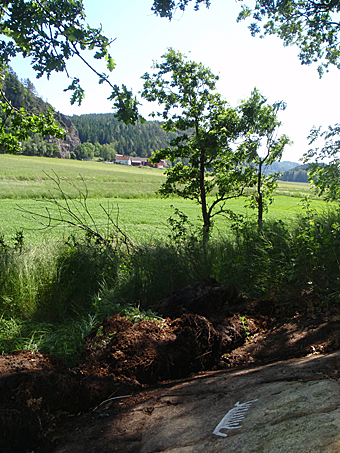 |
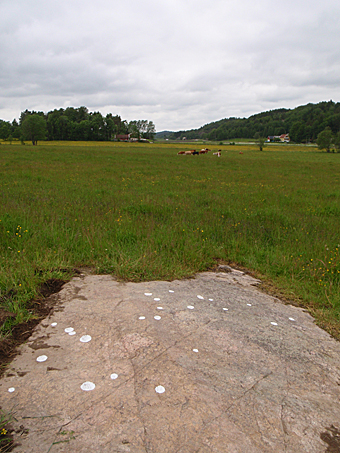 |
|
A new find, a ship discovered on the very last day of our field-work at Medbo. |
Some new finds of cup-marks at Bärby. |
|
Week 22 and 23
This has been two intense weeks of both field- and office work. While we are trying to document as many of the Svarteborg carvings as possible, we are also preparing our report on the carvings at Lökeberg, Foss parish, where we now are completing the documentation of all known carvings.
At the beginning of the week we were joined by Joakim Staxgård, a student getting some practical experience in field-work. We were documenting Svarteborg 577:1 at the Staxäng farm owned by some of the Staxäng family members. And at the end of the week we documented 12:1 at Buråsare mountain; a carving-site including three good-sized surfaces of which one is placed on a vertical rock-face.
Week no 23 we continued at Buråsare mountain at no 11:1. Again, a large carving with several surfaces and levels. There are for instance, 26 ships, two human figures and one swastika. One of the ships, found on a nearly vertical rock-surface, carries a long staff ending in a disc; what we normally call a sun-ship. Two of the human figures, not previously observed, are each holding a disc (shields or sun-signs?). This carving has only been published by Baltzer and is probably one of his least exactly rendered carving. Photographer Anders Jirås accompanied us while we were documenting 11:1. |
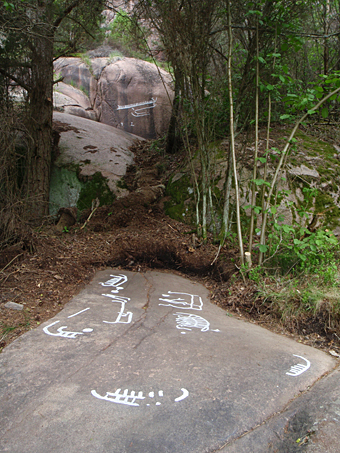 |
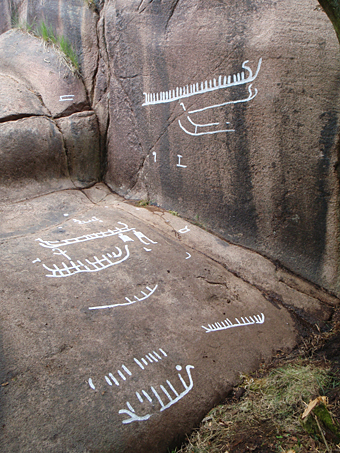 |
|
Svarteborg 12:1, the lower part. In the background one can spot the other two larger surfaces. |
Svarteborg 12:1, the two larger surfaces. It is quite rare to find carvings on a vertical surface. |
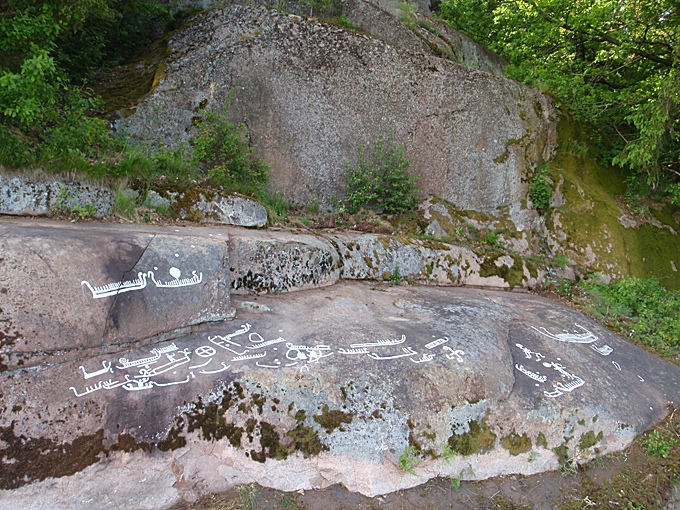 |
|
Svarteborg 11:1 at Bärby, Västergård farm. |
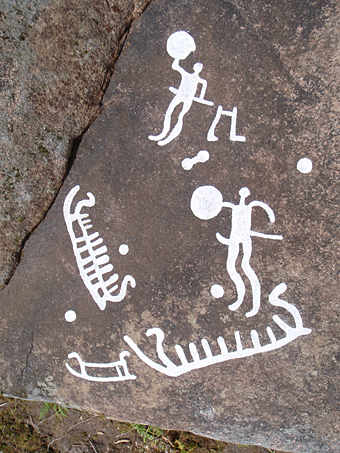 |
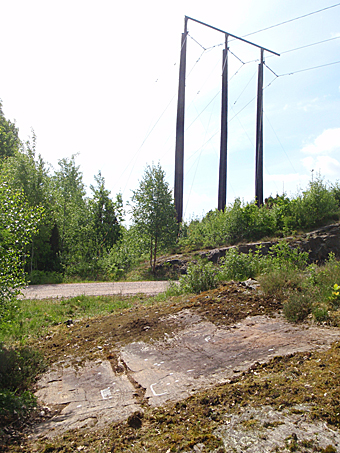 |
|
Svarteborg 12:1, the two new finds: warriors with shields? |
Svarteborg 577:1 on the Staxäng farm. The E6 is right behind the hill. |
|
Week 21
A whole week of wonderful sunshine and summery temperatures allowed us to document a good many carvings. We have finally finished all known carvings in Brastad parish by documenting the two remaining carvings with ships that we found three years ago; Brastad 602 and 604.
We have also documented the carvings at Bärby Östergård in Svarteborg parish; found on a rocky impediment on the Dingle plain. One large carving with many figures is located in a private garden and was discovered by the owners during the 1990s. All images are unusually shallow. Among the many carvings there is a ship with crew is holding their oars in the air. The ship seems to be colliding with another ship (compare Tossene 108:1 in our field-report dated 2002). On yet another carving we found one ship and 17 cup-marks where earlier only one cup-mark had been found.
During the last portion of the week we initiated the work to be done on the many figure-carvings on the Bärby Västergård property below the steep Buråsare mountain. |
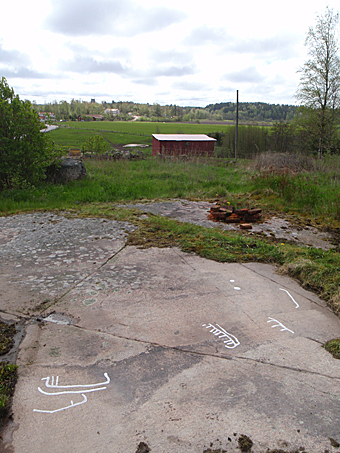 |
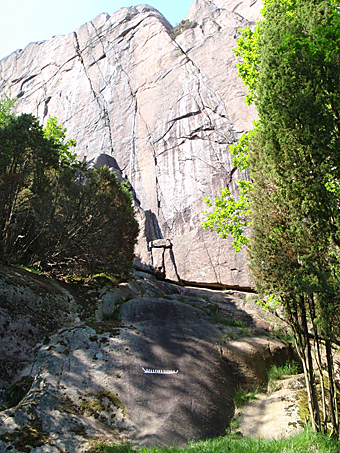 |
|
Brastad 604 at Immestad , looking south to the church. We found carvings here three years ago but have not been able to document them until now. |
The lone ship at Svarteborg 572:1 located at the base of the steep Buråsare mountain at Bärby Västergård. |
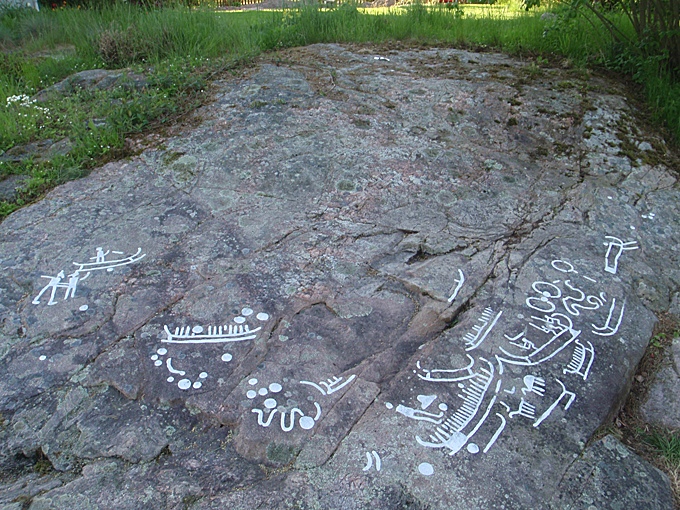 |
| Svarteborg 596:1 at Bärby Östergård located in a private garden. A smooth rock but with a large damaged area at the center. |
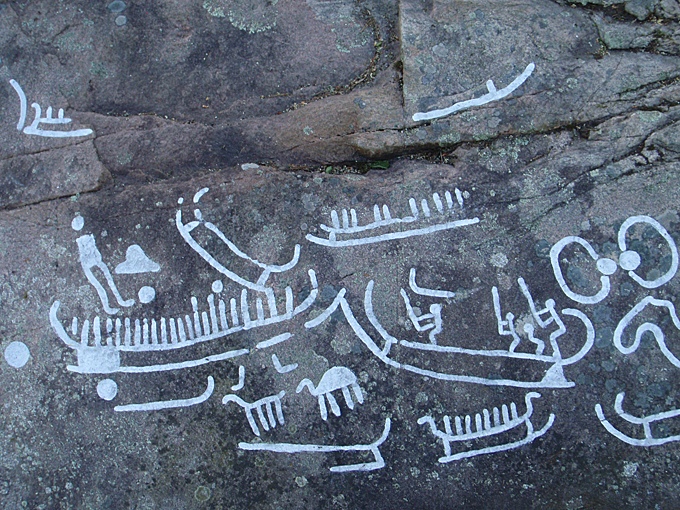 |
|
Detail. Svarteborg 596:1. A scene with colliding ships and something looking like a fibula. |
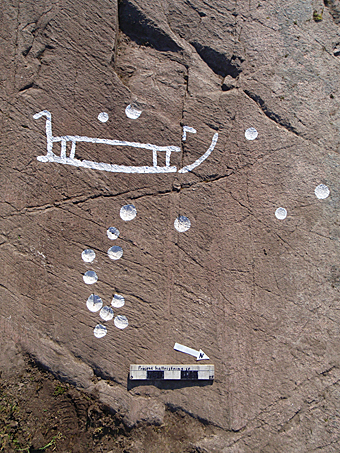 |
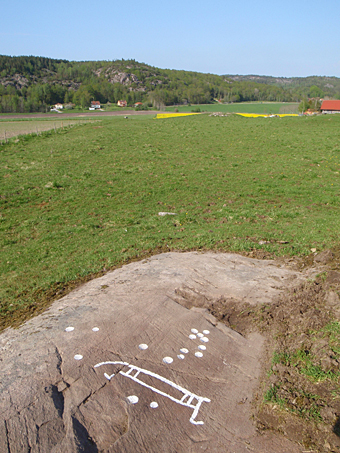 |
|
Svarteborg 574:1, at Bärby Östergård. A double-line ship and 18 cup-marks. Only one cup-mark had been recorded here before. |
Svarteborg 574:1 is situated in a pastoral landscape exposed to the longish valley in the north-east. |
Week 19-20
The weather has been bad and we have only been able to document one large figure-carving; Svarteborg 13:2. This site is located near the large Bärby ship that we documented the week before.
Both sites were known to Baltzer (fig. 17, 1 and two). Just as the Bärby ship, Svarteborg 13:2 has a ship with a disc on top of a frame but in addition this ship has no less than four discs on board! The carving also consists of among other images, yet another frame, an acrobat and several humans with accentuated shoulders. New finds on this site are two foot-soles; one complete and one in contour. The rock-surface is damaged and eroded and we assume some carvings have been destroyed.
We have spent quite a bit of time in the office processing our documentations and much attention has been given the Lökeberg carvings located in the parish of Foss. We hope to publish our findings in a printed report.
We also have had visitors from the University of Vienna who demonstrated their method of documentation using 3-D laser scanning. |
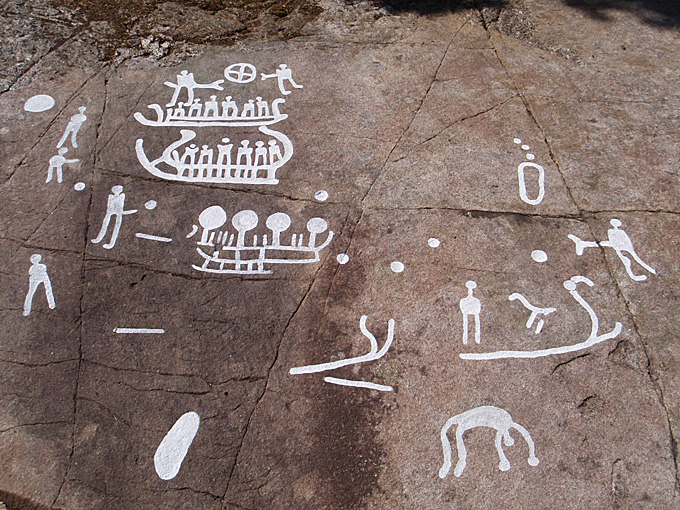 |
|
Portion of Svarteborg 13:2. The upper ship has been carved in several sittings. The legs of the crew are much more deeply cut which could mean the ship originally only had crew-strokes. |
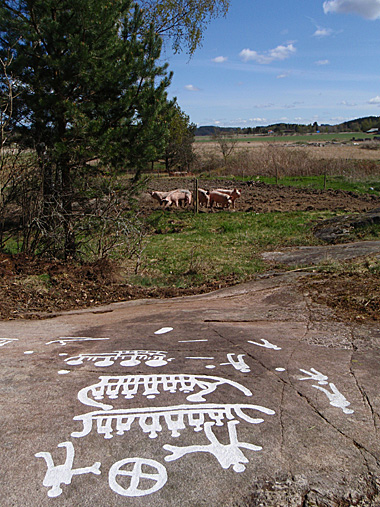 |
Svarteborg 13:2 exposed to the Dingle plain which was a shallow sound during Bronze Age. |
|
In 2010, Lars-Erik Nilsson, commissioned Andreas Toreld and Sven-Gunnar Broström to document some parts of the monumental Kivik grave which we can now make public.
Slab no seven was documented by studying the cast done in the early 20th century and stored at Statens Historiska museum in Stockholm. This allowed them to, at a comfortable pace, trace a horizontal surface.
Thereafter, they complemented this tracing in situ and some small supplements were made; for instance the three curved outgrowths or lines on the pointed oval figure that earlier has been identified as a fish. Perhaps the most interesting supplement is the one on slab no two; a relatively distinctly carved image of a human figure with characteristic shoulders. The image includes what could be construed as a fragmentary lure protruding from the mouth similar to those already seen on slab no one. Earlier it has been argued that only slabs no one and two show humans involved in some kind of activity and that the remaining slabs only contain images of objects and/or symbols.
Slab no two is badly damaged and the ships are much more fragmentary than what earlier tracings show.
Even though the Kivik slabs have been documented several times since they were discovered in the mid-18th century, this rather short visit shows that there are more details and fragments to be discovered on them. A cultural heritage of a dignity such as the grave-monument at Kivik deserves a close scholastic documentation in its entirety. Unfortunately the pigment used in painting the images paint does not give a true picture of the carved images.
|
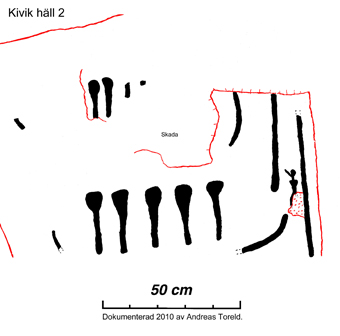 |
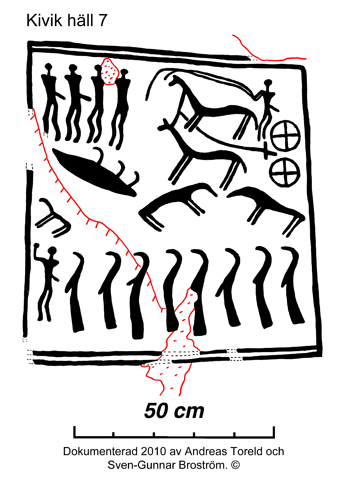 |
|
Week no 18
This was a short week with only three days in the field. But still, we got quite a bit done. We finished documenting the remaining carvings and this parish is now completed. We made some new finds of cup-marks. The most figure-like images in this parish are found at Håby 2:2 within a large grave-field at Backen not far from the Håby-Torp farm. On this site there are several so called cup-and-rings including one that is oval in shape. There are several large grave-fields on the ridge where the carvings are located.
In Svarteborg parish we made three new finds on the east side of the E:6, not very far from Dingle where we also found three graves: one burial mound and two cairns more than ten meters in diameter. Both carvings and graves are located high on a ridge facing Dingle.
Friday we documented our first figure-carving in Svarteborg; the large well-known Bärbyship. |
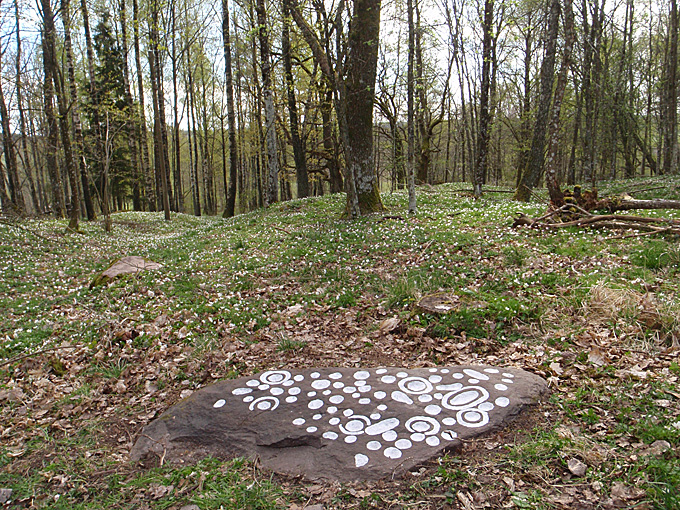 |
|
Håby2:2 at Backen not far from Håby-Torp. The carving is beautifully situated within a grave-field and shaded by leafy deciduous trees. |
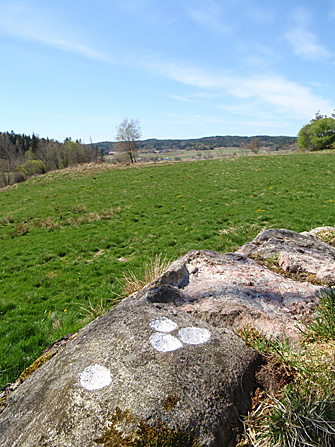 |
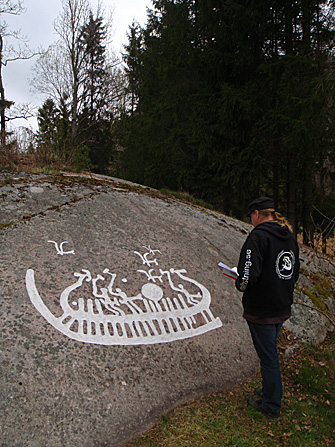 |
|
New find Svarteborg parish, Södra Lågum. In the background, just to the left of the lone tree in the middle of the photo is one of the graves. One can
sense the Dingle plain in the distance. |
The large Bärby-ship, Svarteborg 13:1, filled in with paint. Note that the weapons held by the human figures appear to be two-membered and look very different from the axes that earlier documentation has shown. |
|
Week no 17
We started the week by documenting earlier finds as well as new finds of cup-marks sites in the Foss and Håby parishes. In Foss we found one completely grass-covered site with 50 or so cup-marks. As we started removing grass and soil we found flint-chips, burned clay and part of the rim of a clay pot. So we immediately aborted our investigation and the removal of soil. The position of this site could not be more central in Tungenäset; on an impediment at Närestad from which the whole central valley can be seen, from the church at Foss to Lökeberg and also nearby, on the other side of the creek gorge, the great Pilegård grave-field .
We also made another new find of a cup-mark site with 30 or so carvings at Önne, Håby parish. These two sites are very much alike. Both are on a rather low flat gneiss surface and they are covered with grass and soil and positioned right in the middle of farm-land.
The cup-mark sites in the northern part of Håby are also similar but in a different way; they are located on flat surfaces along the edge of a rocky ridge on an impediment of a rather high elevation.
The weather turned bad so we spent Wednesday and Thursday in the office at Vitlycke museum and we visited the large excavation currently being conducted near the museum where the new stretch of the E-6 thru-way is to be built; right through the Tanum World Heritage area.
|
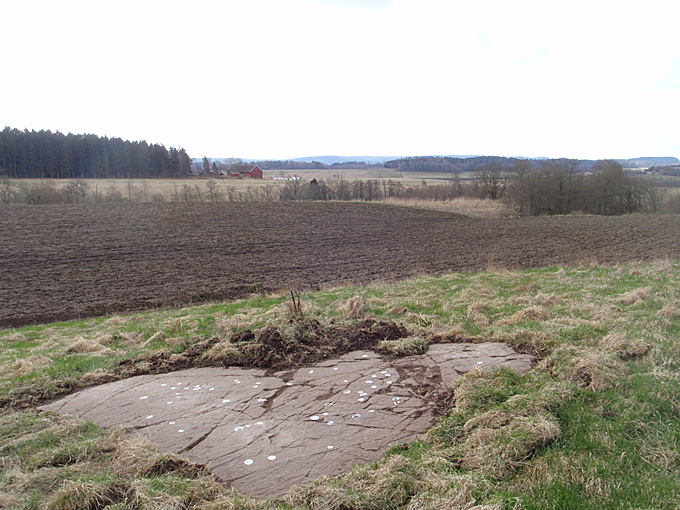 |
|
New find at Närestad, Foss parish. 50 or so cup-marks. The large Pilegård grave-field is located in the woods on the other side of the creek gorge. |
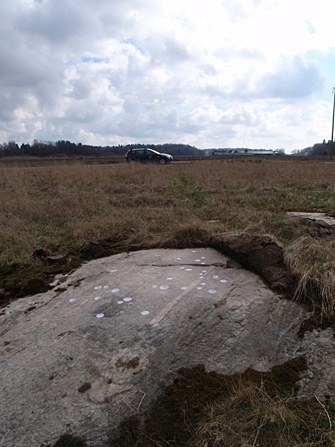 |
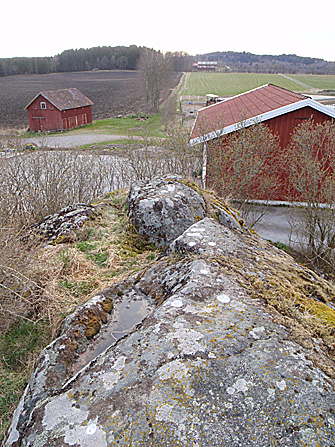 |
|
New find at Öhne, Håby parish. 30 or so cup-marks. |
Håby 11:1-2 in west Solberga. A typical example of how many cup-mark sites within the northern part of the parish, are positioned on top of rather high impediments. |
|
Week no 16
The first week of this season the weather was unstable but still we managed to visit five different parishes. We began the week by doing a small study in Brastad on behalf of Bohuslän regional museum. Also, we paid Tossene parish a short visit where Ingemar, who does the landscaping around the parish church, showed us several newly found carvings .We hope to document these later when the ground is dryer.
Our main task this spring is to document the three parishes of Foss, Håby and Svarteborg, all within the Munkedal municipality. Already during our first week we have made new discoveries of carvings in all four and we have documented both these and the already known ones. However, only sites with cup-marks so far.
In the parish of Håby there are 18 documented carved sites, one is destroyed, all only with cup-marks. In Svarteborg there are 66 known sites of which six are documented and destroyed and three more, known but not found. Several of the Svarteborg sites are large exciting panels with other types of carved images of which most have not been documented or published. All previously known Svarteborg carvings are located along the western side of the Dingle plain.
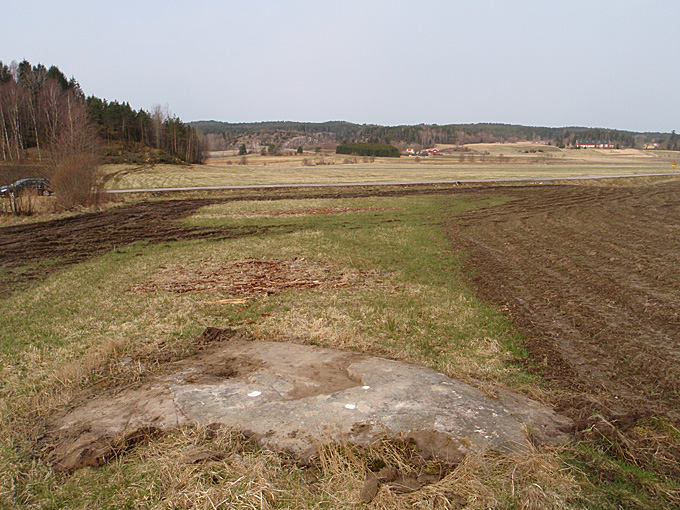 |
|
A new find on the Leråker farm in Svarteborg. The first known carving located on the eastern side of the Dingle plain. |
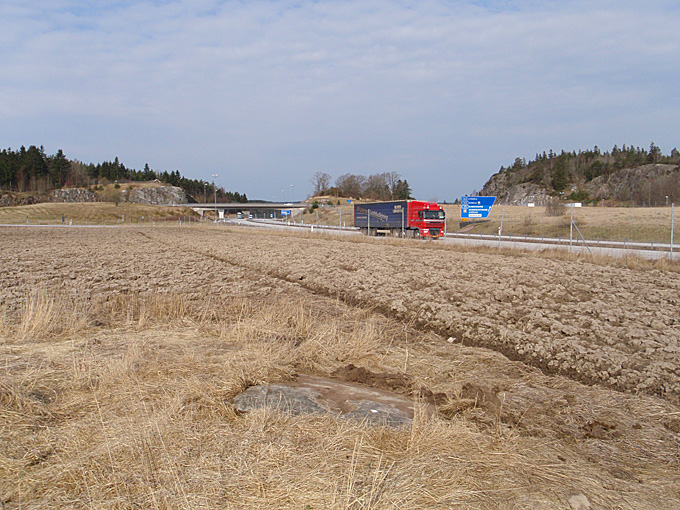 |
|
Håby 4:2, Gläborg, right by the freeway. Håby 4:1 was demolished when the road was built. |
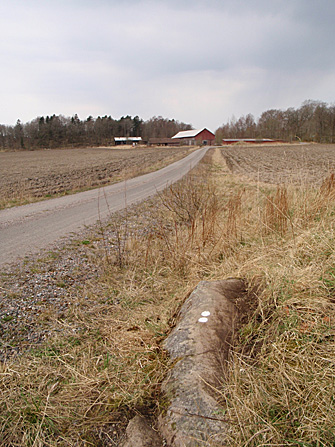 |
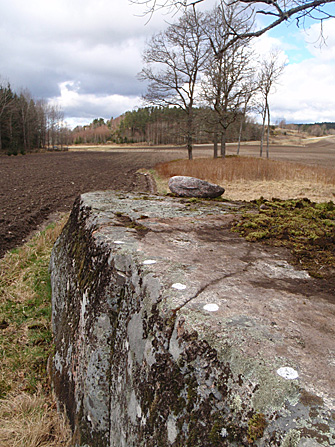 |
|
Håby parish, new find at Gläborg located on bedrock just one meter from the new gravel road. |
Foss 20:1, situated on the Berg farm. All five cup-marks are placed in a straight line along the edge of the rock. |
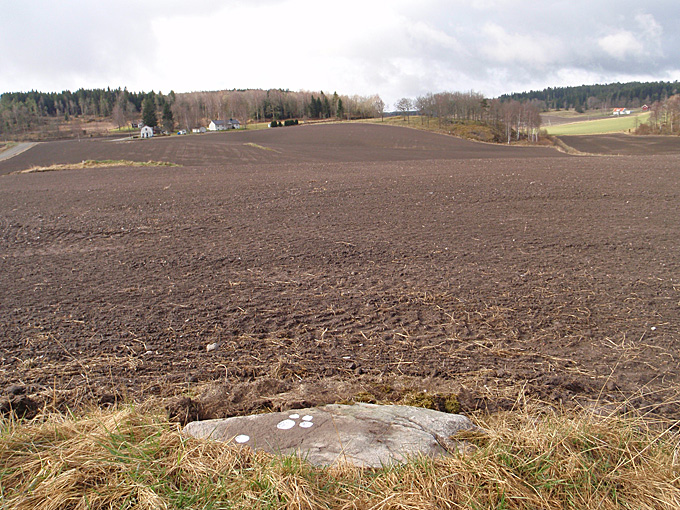 |
|
A new find in Foss on the ridge at Kampstorp, not far from the E-6. | |
|


